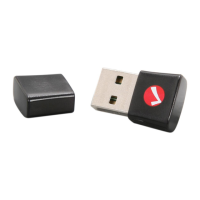15
CONfIGURATION
• TKIP (Temporal Key Integrity Protocol) changes the temporal key every
10,000 packets. (A packet is a kind of message transmitted over a network.)
This ensures much greater security than standard WEP security.
• AES has been developed to ensure the highest degree of security and
authenticity for digital information. It’s the most advanced solution dened by
IEEE 802.11i for security in the wireless network.
ASCII / PASSPHRASE: WEP key entries can be in ASCII or passphrase format.
• ASCII uses alphanumeric values or signs, making it more easily recognizable
for users.
• PASSPHRASE entries require a text string with a maximum of 32 alphanumeric
characters; for example, “Test.” The same passphrase or WEP key settings
must be used for all wireless computers within the network. NOTE: Due to
possible incompatibility with other manufacturers’ passphrase generators, a
passphrase may not work with other product brands.
Key Length: When “WEP” and “PASSPHRASE” are selected, this option displays.
• 64-bit lets you input 10-digit hexadecimal values as the encryption keys; for
example, “0123456aef.”
• 128-bit lets you input 26-digit hexadecimal values as the encryption keys; for
example, “01234567890123456789abcdef.”
Key Index (advanced): Select one of the four keys to be the data encryption key.
Network Key: Enter the network security key here to make sure the password is
correct.
Conrm Network Key: Enter the network security key again.
EAP Type: The Extensible Authentication Protocol drop-down menu offers four
options.
• GTC is an authentication protocol that allows the exchange of clear text
authentication credentials across the network.
• TLS is the most secure of the EAP protocols, but isn’t easy to use. It requires
that digital certicates be exchanged in the authentication phase. The server
presents a certicate to the client and, after validating the server’s certicate,
the client presents a client certicate to the server for validation.
• LEAP is a pre-EAP, Cisco-proprietary protocol with many of the features of
EAP protocols. Cisco controls the ability of other vendors to implement this
protocol, so it should be selected for use only when limited brand choice for
client, access-point and server products is not a concern. Once you’ve set up
LEAP authentication, you need to enter the username and password of your
computer.
• PEAP & TTLS are similar to, yet easier than, TLS in that they specify a stand-
alone authentication protocol be used within an encrypted tunnel. TTLS
supports any protocol within its tunnel, including CHAP, MSCHAP, MSCHAPv2

